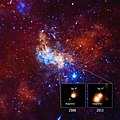File:Magnetar-SGR1745-2900-20150515.jpg

原始文件 (3,600 × 3,600像素,文件大小:3.55 MB,MIME类型:image/jpeg)
摘要
| 描述Magnetar-SGR1745-2900-20150515.jpg |
English: In 2013, astronomers announced they had discovered a magnetar exceptionally close to the supermassive black hole at the center of the Milky Way using a suite of space-borne telescopes including NASA’s Chandra X-ray Observatory.
Magnetars are dense, collapsed stars (called “neutron stars”) that possess enormously powerful magnetic fields. At a distance that could be as small as 0.3 light years (or about 2 trillion miles) from the 4-million-solar mass black hole in the center of our Milky Way galaxy, the magnetar is by far the closest neutron star to a supermassive black hole ever discovered and is likely in its gravitational grip. Since its discovery two years ago when it gave off a burst of X-rays, astronomers have been actively monitoring the magnetar, dubbed SGR 1745-2900, with Chandra and the European Space Agency’s XMM-Newton. The main image of the graphic shows the region around the Milky Way’s black hole in X-rays from Chandra (red, green, and blue are the low, medium, and high-energy X-rays respectively). The inset contains Chandra’s close-up look at the area right around the black hole, showing a combined image obtained between 2005 and 2008 (left) when the magnetar was not detected, during a quiescent period, and an observation in 2013 (right) when it was caught as a bright point source during the X-ray outburst that led to its discovery. A new study uses long-term monitoring observations to reveal that the amount of X-rays from SGR 1745-2900 is dropping more slowly than other previously observed magnetars, and its surface is hotter than expected. The team first considered whether “starquakes” are able to explain this unusual behavior. When neutron stars, including magnetars, form, they can develop a tough crust on the outside of the condensed star. Occasionally, this outer crust will crack, similar to how the Earth’s surface can fracture during an earthquake. Although starquakes can explain the change in brightness and cooling seen in many magnetars, the authors found that this mechanism by itself was unable to explain the slow drop in X-ray brightness and the hot crustal temperature.. Fading in X-ray brightness and surface cooling occur too quickly in the starquake model. The researchers suggest that bombardment of the surface of the magnetar by charged particles trapped in twisted bundles of magnetic fields above the surface may provide the additional heating of the magnetar’s surface, and account for the slow decline in X-rays. These twisted bundles of magnetic fields can be generated when the neutron star forms. The researchers do not think that the magnetar’s unusual behavior is caused by its proximity to a supermassive black hole, as the distance is still too great for strong interactions via magnetic fields or gravity. Astronomers will continue to study SGR 1745-2900 to glean more clues about what is happening with this magnetar as it orbits our galaxy’s supermassive black hole. These results appear in Monthly Notices of the Royal Astronomical Society in a paper led by the PhD student Francesco Coti Zelati (Universita’ dell’ Insubria, University of Amsterdam, INAF-OAB), within a large international collaboration. NASA's Marshall Space Flight Center in Huntsville, Alabama, manages the Chandra program for the agency’s Science Mission Directorate in Washington. The Smithsonian Astrophysical Observatory in Cambridge, Massachusetts, controls Chandra's science and flight operations. |
| 日期 | |
| 来源 | http://www.nasa.gov/mission_pages/chandra/magnetar-near-supermassive-black-hole-delivers-surprises.html |
| 作者 | NASA/CXC/INAF/F. Coti Zelati et al. |
许可协议
| Public domainPublic domainfalsefalse |
| 本文件完全由NASA创作,在美国属于公有领域。根据NASA的版权方针,NASA的材料除非另有声明否则不受版权保护。(参见Template:PD-USGov/zh、NASA版权方针页面或JPL图片使用方针。) |  | |
 |
警告:
|
说明
23 9 2014
image/jpeg
文件历史
点击某个日期/时间查看对应时刻的文件。
| 日期/时间 | 缩略图 | 大小 | 用户 | 备注 | |
|---|---|---|---|---|---|
| 当前 | 2015年5月15日 (五) 14:08 |  | 3,600 × 3,600(3.55 MB) | Drbogdan | User created page with UploadWizard |
文件用途
以下页面使用本文件:
全域文件用途
以下其他wiki使用此文件:
- af.wikipedia.org上的用途
- el.wikipedia.org上的用途
- en.wikipedia.org上的用途
- es.wiktionary.org上的用途
- ja.wikipedia.org上的用途
- ka.wikipedia.org上的用途
- mk.wikipedia.org上的用途
- pt.wikipedia.org上的用途
元数据
此文件中包含有扩展的信息。这些信息可能是由数码相机或扫描仪在创建或数字化过程中所添加。
如果此文件的源文件已经被修改,一些信息在修改后的文件中将不能完全反映出来。
| 作者 | Chandra X-ray Observatory Center |
|---|---|
| 来源 | Chandra X-ray Observatory |
| 使用条款 | |
| 宽度 | 3,600 px |
| 高度 | 3,600 px |
| 每色彩组分位数 |
|
| 压缩方案 | LZW |
| 像素构成 | RGB |
| 方向 | 正常 |
| 色彩组分数 | 3 |
| 水平分辨率 | 300 dpi |
| 垂直分辨率 | 300 dpi |
| 数据排布 | 大块格式 |
| 使用软件 | Adobe Photoshop CC 2014 (Macintosh) |
| 文件修改日期时间 | 2015年5月13日 (三) 12:30 |
| Exif版本 | 2.21 |
| 色彩空间 | sRGB |
| 数字化日期时间 | 2014年9月23日 (二) 12:52 |
| 元数据最后修改日期 | 2015年5月13日 (三) 07:30 |
| 评分(满分5分) | 0 |
| 原始文件唯一ID | 4CB4E53C10E28FA4895D0EBBC8579AD6 |
| 著作权状况 | 著作权状况未设置 |
| 联系信息 | cxcpub@cfa.harvard.edu
60 Garden St. Cambridge, MA, 02138 USA |
| IIM版本 | 4 |

